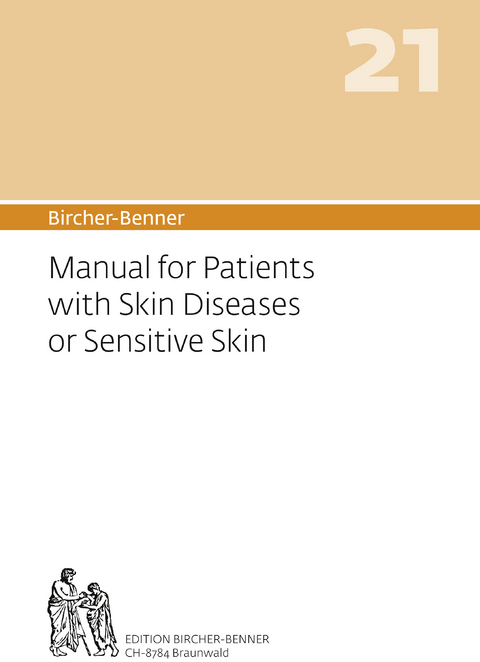
Bircher-Benner 21 Manual for Patients with Skin Diseases or Sensitive Skin
Bircher-Benner (Verlag)
978-3-906089-32-4 (ISBN)
Dr. med. Andres Bircher grandson of Dr.med. Maximilian Bircher-Benner. Medical studies in Zürich and Geneva, ten years practice as a hospital physician in anaesthesiology, intensive care, emergency medicine, surgery, paediatrics, psychosomatics, haematology, geriatrics, psychiatry and psychotherapy, medical specialist(Facharzt) in an administrative position at Zürich university hospitals, teaching analysis with Brian Kenny, chief physician (Chefarzt) of a hospital for internal medicine in Zurich and later in Western Switzerland, medical specialist (Facharzt) in TCM and acupuncturist in Vienna; studies of neural therapy, manual therapy and traditional homeopathy, successful completion of medical specialist (Facharzt) training in balneology, climatology and physical medicine in Germany, scientific work on food energies, dietetics and the effects of regulatory medicine. Dr. med. Andres Bircher is the medical manager of the Centre for Scientific Natural Medicine Bircher-Benner.
Angaben zur Person: Über den Autor: Dr.med. Andres Bircher ist Enkel von Dr.med. Maximilian Bircher-Benner. Nach dem Medizinstudium in Zürich und Genf, zehnjährige Tätigkeit als Spitalarzt in Anästhesiologie, Intensivmedizin, Rettungswesen, Chirurgie, Kinderheilkunde, Psychosomatik, Hämatologie, Geriatrie, Psychiatrie und Psychotherapie, als Facharzt an Zürcher Universitätskliniken in leitender Position. Lehranalyse bei Brian Kenny. Chefarzt einer Klinik für Innere Medizin in Zürich und später in der Westschweiz, Studium und Facharztausbildung in TCM und Akupunktur in Wien, Neuraltherapie, Manualtherapie, klassische Homöopathie, Ausbildung zum deutschen Facharzt in Balneologie, Klimatologie und physikalische Medizin. Wissenschaftliche Arbeiten über die Nahrungsenergie, Diätetik und die Wirkungen der regulativen Medizin. Ärztlicher Leiter des medizinischen Zentrums Bircher-Benner
Table of Contents
Preface 10
Our Skin Reflects Our Health 12
Skin Structure 19
The Epidermis 19
The Dermis 19
The Subcutis19
Innervation of the Skin, the Miracle of Sensitivity20
Cutivisceral Reflexes and Dermatomes22
Transferred Pain23
Respiration of the Skin (Perspiration)24
Sweat Glands (Glandula Sudorifera)25
The Sebaceous Glands (Glandula Sebacea)26
The Skin Flora27
Resident Flora or Normal Flora27
Transient Colonisation28
The Acid Mantle of the Skin28
Moisture and Dryness of the Skin28
Skin Zones with Particularly High Fat Content29
The Immune System and the Skin30
The Innate, Non-Specific Immune Response30
The Cells of the Specific Immune Defence32
Antibodies33
Maturing and Ageing of the Immune System34
Excessive Immune Response35
Autoimmune Disorders35
Treatment of the Causes of Immunodeficiency and Overreaction36
Infectious Diseases of the Skin38
Bacterial Infections38
Pyoderma38
Acne39
Rosacea43
Furunculosis46
Erythema Migrans, Lyme Disease46
Atheroma47
Skin Tuberculosis (Lupus Vulgaris)48
Herpes Simplex48
Chickenpox (Varicella)49
Herpes Zoster (Shingles)49
Herpes Zoster Ophthalmicus49
Fungal Infections of the Skin (Dermatomycoses)50
Exanthema52
Eczema53
The Acute Stage53
The Chronic Stage53
Special Forms of Eczema53
Complications of Eczema55
Hives (Urticaria)56
Triggers of Urticaria56
Chronic Urticaria56
Urticaria Factitia56
Rare Forms of Urticaria57
Heavy-Metal Exposure as a Cause of Urticaria57
Treatment of Urticaria57
Treatment of Urticaria through Treatment of Its Causes57
Neurodermatitis (Atopic Eczema)59
Causes of Neurodermatitis59
Immunological Processes60
Vitamin D Deficiency61
Vitamin E61
Vitamin B1261
The Milieu and Microbiome in the Intestine Are the Most Important Causes of Neurodermatitis62
Causes in the Nervous System and in the Hormonal System63
The Disturbed Circadian Rhythm as a Contributing Cause of Neurodermatitis63
Environmental Factors as a Cause of Neurodermatitis63
Heavy-Metal Exposure and Neurodermatitis63
Diet and Neurodermatitis63
Provocation Factors65
Complications of Neurodermatitis66
Special Forms of Neurodermatitis66
Concomitant Symptoms of Neurodermatitis66
Psychological Consequences of Neurodermatitis66
Treatment of Neurodermatitis67
Basic Care67
Treatment with Glucocorticoids (Corticosteroids)68
Other Immunosuppressants73
Antihistamines74
Phototherapy and Climate Treatment74
Spas75
Curing Neurodermatitis by Treating its Causes75
Homoeopathic Treatment of Neurodermatitis76
Psoriasis (Psoriasis Vulgaris)78
The Epidemiology of Psoriasis78
Causes of Psoriasis78
Occurrences in the Skin and the Appearance of Psoriasis79
Involvement of Internal Organs in Psoriasis81
The Psychological Effect of Psoriasis82
Triggering and Aggravating Risk Factors of Psoriasis82
Common Treatment of Psoriasis83
Treatment of Psoriasis by Addressing its Causes88
Vitiligo93
The Common Treatment of Vitiligo93
Treatment of Vitiligo by Addressing its Causes94
Skin Warts95
The Role of the Immune System95
Treatment of Warts97
Prevention of Warts99
Seborrhoeic Keratosis (Verruca Seborrhoica)100
Treatment of Seborrhoeic Keratosis100
Actinic Keratosis101
Treatment of Actinic Keratosis101
Birthmarks (Nevus)103
Lipoma105
Liposarcoma106
White Skin Cancer107
Black Skin Cancer (Malignant Melanoma)108
Heredity as a Contributing Cause of Malignant Melanoma109
Treatment of Malignant Melanoma109
Melanocarcinoma and Diet110
Order Therapy for Skin Diseases113
The Diet113
The Gut-Skin Axis and the Gut-Brain Axis114
The Problem of Food Energy115
Two Kinds of Food Energy115
The Basic Regulation of the Soft Connective Tissue (Matrix)117
The Integral Law of Nutrition119
Vibrancy of Food119
The Meaning of Food Economy119
Secondary Plant Substances (Phytochemicals)120
Nutritive Stimulus121
The Meaning of Movement121
The Meaning of the Climate121
The Meaning of Sleep122
The Meaning Skin Care122
The Water Treatments123
General Guidelines for Order Therapy125
Treatment Plans and Menus128
Diet Stage I: the Fresh Juice and Almond Milk Diet128
Diet Stage II: the Vegan Raw Food Diet128
Diet Stage III: the Vegan, Wheat-Free and Yeast-Free Diet with 1⁄3 Warm Wholefood128
Diet Stage IV: the Lacto-Vegetarian Wholefood Diet128
Notes on Diet Stage I129
Possible Reactions during Diet Stage I, the Pure Fresh Juice and Almond Milk Diet and Their Treatment129
Diet Plan for Diet Stage I130
Mixed Juices130
Recipes140
Fresh Juices140
Vegetable Juices140
Healthy Teas141
Bircher Muesli143
Sprouted Cereal Grains145
Raw Vegetables and Salads145
Salad Dressings146
Mayonnaise148
Raw Vegetables and Accompanying Dressings148
Suggestions for Dressings to go with Salads and Raw Vegetables149
Milk Types151
Butter, Vegetable Fats and Oils152
Gentle Cooking and Steaming153
Soups153
Vegetables158
Salad of Cooked Vegetables167
Potato Dishes169
Grain Dishes173
Sauces178
Sandwiches181
Basic Spreads181
Desserts182
List of Recipes and Treatment Plans189
Notes190
Preface Beautiful skin is more than just a matter of aesthetics. First and foremost it is a matter of health. In full health, a body will preserve its harmonious natural shape into old age, without any abnormal fat deposits – flabby, bloated tissue and the nodular deposits under the skin – commonly known as “cellulite” and without varicose veins. Muscles remain elastic, the posture upright, the gait smooth, light and free, and the skin stays warm and well-supplied with blood. What is visible on the outside is reflected on the inside as well. The skin is a mirror of our health – our most visible organ. It keeps track of our lives and provides a record of our health. Our traumas, mind, fears, hardness, anger and kindness are engraved upon the skin as if it were a book of our life, the individual chapters a thousand wrinkles and folds which give our faces their character and make them unique. Skin that is fresh and rosy with adequate blood supply will radiate life and friendliness. If it is pale it speaks of anaemia, weakness and exhaustion. A yellow tint shows that the metabolism, and specifically the liver, is overloaded and ill. A grey shade reflects poisoning and bitterness. Impure skin indicates disease, a sick intestine, a sick metabolism, a sick immune system. Few skin diseases are inherited, although some can be. Neurodermatitis and psoriasis may occur in families, and much research has been done to find their genetic causes. Modern genetics increasingly finds inheritable factors in acquired traits, i.e. a congenital background of the expressivity of genes without any modification to the sequence of the base gene pairs. Epidemiological studies have revealed an impressive correlation between the diet of parents and the incidence of diabetes or cardiovascular disease in their children. Though recent studies reflect examples of epigenetic inheritance in various model organisms, researchers do not yet understand the underlying molecular mechanisms. An individual’s genetic predisposition will determine how well foreign substances can penetrate barriers such as their skin, and how their immune system reacts to stimuli from the environment and the consequences thereof. In contrast to some hereditary diseases, allergic diseases are not caused by a single, altered gene. Instead, a complex interaction of various genetic factors in different areas of the genetic material and in different genes comes into play. Neurodermatitis is clinically similar to the scabies mite disease, but without any mites. Psoriasis is similar to a fungal infection, but without the presence of fungus. These are indications of epigenetic inheritance of the aforementioned diseases. Neurodermatitis is also called atopy (from the ancient Greek ατοπíα, atopía, “placelessness”). Medically, atopy means a tendency to develop hypersensitivity reactions, specifically allergic reactions to contact with otherwise harmless substances from the environment. The epigenetic inheritance of atopy has become the focus of interest in modern genetic research. With psoriasis, the disease has penetrated more deeply. Autoimmune reactions are active, i.e. reactions of the immune system against structures of the skin. The immune cells, or lymphocytes, are formed in the bone marrow before migrating to the gigantic intestinal mucosa. The intestine relays extremely close contact between foreign substances and the body’s own tissue. This is where the lymphocytes, as dendritic cells, learn to distinguish between foreign and own materials. Only 10% of lymphocytes reach full immunocompetence and migrate into the body to do their work there; the others are eliminated. Autoimmune diseases develop when the intestinal milieu is ill from intestinal malcolonisation and a damaged mucosal barrier. They are caused by an improper diet in relation to our biological system. Incompetent lymphocytes enter the body and react to the body’s own tissue. This is a very important partial cause of psoriasis. Exposure to heavy metals and other toxins has been shown to be another partial cause in addition to epigenetic inheritance. Patients suffer greatly under neurodermatitis, and those with psoriasis suffer nearly as much. Patients have already experienced the disappointment of therapies that merely suppress their symptoms. They have learned that such therapies only make the disease chronic. Both diseases can be cured by addressing the causes through strict detoxification, a healing diet of fresh plant-based food and a new order of life, all customised for the patient after allergy testing. Homoeopathy alone cannot cure such diseases. However, it may erase the epigenetic hereditary component of neurodermatitis and psoriasis step by step if individually and precisely adjusted to the patient, and at gradually increased potency. Diet and lifestyle are also of vital importance for other skin diseases. Treatment of the causes, rather than suppression of symptoms, is decisive for the healing of skin diseases. This is a path that requires detailed understanding from the patient and their doctor, a joint path which can turn out to be very profitable. Our greatest teachers are the patients who have been healed over the course of more than a century by our fresh plant-based diet, by a new order of life and by the attentive psychological support at the famous Bircher-Benner Medical Centre in Zurich (now the medical centre in Braunwald). This manual provides patients and relatives with the knowledge and practical instructions needed to successfully and permanently cure skin diseases. For the treating physician, this manual is an important aid in the instruction and guidance of patients. May 2022 Dr. med. Andres Bircher
PrefaceBeautiful skin is more than just a matter of aesthetics. First and foremost it is a matter of health. In full health, a body will preserve its harmonious natural shape into old age, without any abnormal fat deposits - flabby, bloated tissue and the nodular deposits under the skin - commonly known as "cellulite" and without varicose veins. Muscles remain elastic, the posture upright, the gait smooth, light and free, and the skin stays warm and well-supplied with blood. What is visible on the outside is reflected on the inside as well. The skin is a mirror of our health - our most visible organ. It keeps track of our lives and provides a record of our health. Our traumas, mind, fears, hardness, anger and kindness are engraved upon the skin as if it were a book of our life, the individual chapters a thousand wrinkles and folds which give our faces their character and make them unique. Skin that is fresh and rosy with adequate blood supply will radiate life and friendliness. If it is pale it speaks of anaemia, weakness and exhaustion. A yellow tint shows that the metabolism, and specifically the liver, is overloaded and ill. A grey shade reflects poisoning and bitterness. Impure skin indicates disease, a sick intestine, a sick metabolism, a sick immune system.Few skin diseases are inherited, although some can be. Neurodermatitis and psoriasis may occur in families, and much research has been done to find their genetic causes. Modern genetics increasingly finds inheritable factors in acquired traits, i.e. a congenital background of the expressivity of genes without any modification to the sequence of the base gene pairs. Epidemiological studies have revealed an impressive correlation between the diet of parents and the incidence of diabetes or cardiovascular disease in their children. Though recent studies reflect examples of epigenetic inheritance in various model organisms, researchers do not yet understand the underlying molecular mechanisms. An individual's genetic predisposition will determine how well foreign substances can penetrate barriers such as their skin, and how their immune system reacts to stimuli from the environment and the consequences thereof. In contrast to some hereditary diseases, allergic diseases are not caused by a single, altered gene. Instead, a complex interaction of various genetic factors in different areas of the genetic material and in different genes comes into play. Neurodermatitis is clinically similar to the scabies mite disease, but without any mites. Psoriasis is similar to a fungal infection, but without the presence of fungus. These are indications of epigenetic inheritance of the aforementioned diseases. Neurodermatitis is also called atopy (from the ancient Greek pií , atopía, "placelessness"). Medically, atopy means a tendency to develop hypersensitivity reactions, specifically allergic reactions to contact with otherwise harmless substances from the environment. The epigenetic inheritance of atopy has become the focus of interest in modern genetic research.With psoriasis, the disease has penetrated more deeply. Autoimmune reactions are active, i.e. reactions of the immune system against structures of the skin. The immune cells, or lymphocytes, are formed in the bone marrow before migrating to the gigantic intestinal mucosa. The intestine relays extremely close contact between foreign substances and the body's own tissue. This is where the lymphocytes, as dendritic cells, learn to distinguish between foreign and own materials. Only 10% of lymphocytes reach full immunocompetence and migrate into the body to do their work there; the others are eliminated. Autoimmune diseases develop when the intestinal milieu is ill from intestinal malcolonisation and a damaged mucosal barrier. They are caused by an improper diet in relation to our biological system. Incompetent lymphocytes enter the body and react to the body's own tissue. This is a very important partial cause of psorias
| Erscheinungsdatum | 25.05.2022 |
|---|---|
| Verlagsort | Braunwald |
| Sprache | englisch |
| Maße | 150 x 210 mm |
| Gewicht | 320 g |
| Themenwelt | Medizin / Pharmazie ► Naturheilkunde |
| Schlagworte | actinic keratosis • Atheroma • basal cell carcinoma • Bircher-Benner • Bircher-Benner 21 • Bircher-Benner Diet • Black Skin Cancer • Cervical carcinoma • Condylomata acuminata • Cure acne naturally • Cure Atopic Eczema Permanently • Cure Eczema • Cure Lyme Disease • Cure neurodermatitis permanently • Cure psoriasis naturally • Cure Skin Disease Naturally • Cure Urticaria • Cure urticaria naturally • Definitely cure psoriasis • Erythema Migrans • Fungal infections of the skin • Furunculosis • Genital Warts • Herpes • Herpes Zoster • lipoma • malignant melanoma • Mercury and Neurodermatitis • Mycoses • raw food diet • Seborrhoeic Eczema • sensitive skin • skin cancer • Skin Disease • Skin Disease Naturopathy • skin diseases • Skin sensitive • vegan diet • Vegan Raw Food • Vegetable Fresh Food • White skin cancer |
| ISBN-10 | 3-906089-32-0 / 3906089320 |
| ISBN-13 | 978-3-906089-32-4 / 9783906089324 |
| Zustand | Neuware |
| Haben Sie eine Frage zum Produkt? |
aus dem Bereich


